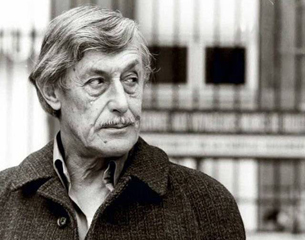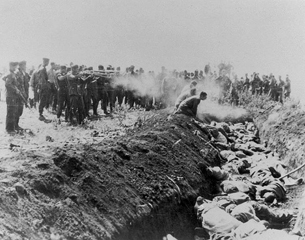
This article was written in 1986.
Babi Yar has become a household name. Like St. Bartholomew's Day, the Gulag, Hiroshima, Chernobyl... Mass murder—that is the meaning of these words, names, and concepts.
Which of these concepts is more terrifying is hardly worth delving into. But each had its own nuance. To deal with the Huguenots, slave labor, to bring Japan to its knees; with Chernobyl—what actually happened is still not clear.
With Babi Yar—it became clear after the first burst of machine-gun fire. The Jews must be destroyed—and that’s all!
They were exterminated for three days—September 29, September 30, and October 1, 1941. It is said that 70,000 people were shot on those three days... Of them, only one person survived—Dina Mironovna Pronicheva, an actress from the Kyiv Puppet Theater and a mother of two. The only person in the whole world who could and did tell what happened in that deep ravine on the outskirts of Kyiv during those terrible three days. Her detailed, blood-curdling account is given in full in Anatoly Kuznetsov’s well-known book “Babi Yar.”
Reading it, you ask yourself a thousand questions. But the main one is: what force, what measure of malice could drive a person, the people who took part in this murder, to what was done? How could the expressions “human-beast,” “brutal massacre,” and “animal hatred” have come into being? Not a single beast, not even the most ferocious, tortures its victim the way a human tortures another human... A beast wants to eat, to protect its young; sadism is unknown to it. The Jews of Babi Yar, the elderly and the children, were beaten with clubs and stripped naked before being shot...
In the following two years, it wasn't only Jews who were shot in Babi Yar. The figure cited is 30,000. Whether they were beaten or stripped naked is unknown. But for the first three days, people were beaten and stripped naked simply because they were Jews. In Hitler's language, this was called the “Final Solution to the Jewish Question.”
And then the war ended. Kyiv was liberated. At the Nuremberg trials, Babi Yar was mentioned, and figures were cited. And in Kyiv itself?
When, almost twenty years later, I tried to mention a monument at the site of the shooting (I almost wrote “brutal” shooting, but caught myself), they looked at me as if I were insane: “What monument? For whom? Monuments are erected for heroes. But here—these people went willingly, like rabbits into the mouth of a boa constrictor...” And right then, the order was given to fill in Babi Yar. So that no trace of it would remain...
It's not for me to defend fascism. But there, it was said: Jews are subhuman, they must be destroyed! Clear! But with us—it's a fraternal family of peoples, all are equal! Well, what about the tragedy of Babi Yar? What tragedy? No tragedy. Forget it! And they renamed it Syretsky Yar. And then they filled it in. With pumps, with pulp—a mixture of clay and sand. And the ravine turned into a wasteland overgrown with weeds...
In 1961, a catastrophe occurred. The dam holding back the filled-in part of Babi Yar broke. Millions of tons of pulp rushed into the Kurenivka neighborhood. A ten-meter-high wave of liquid sand and clay flooded the tram depot, wiping out small houses and homesteads clinging to the slopes. There were many victims... A month later, three lines about it appeared in the “Vecherniy Kyiv” newspaper.
As is well known, logic is not the strongest feature of communist ideology. First, they decided to forget and fill in Babi Yar. Then they destroyed the old Jewish cemetery adjacent to Babi Yar. They desecrated and shattered the monuments... Then they dispersed the people who, on the 25th anniversary of the shootings, had gathered at the place where their fathers, brothers, and sisters had perished. The participants of this so-called “Zionist gathering” began to be reprimanded, summoned to the Party Bureau. Including me...
Two weeks later, next to the highway leading to Shuliavka, a stone suddenly appeared with an inscription stating that a monument to the victims of the temporary fascist occupation of the city of Kyiv would be erected here. Soon after, a competition for this monument was announced.
The competition's conditions stated that the monuments should “artistically reflect the heroism, unyielding will, courage, and fearlessness of our people in the face of death at the hands of German executioners, should show the brutal face of the Hitlerite invaders, and should also express the nationwide grief for thousands of unsung heroes.”
Had I taken part in the competition, I would have been at a loss... The rabbits had turned into heroes, and the terrified, helpless, and beaten old men and women were, it turns out, supposed to display unyielding will, courage, and fearlessness in the face of death at the hands of German executioners. Some kind of delirium...
Nevertheless, ten years later, this delirium became a reality. I haven't seen the monument in person; it's very difficult to understand what's going on from a photograph, but there are plenty of muscles and confident gazes into the bright future...
Incidentally, the competition mentioned above turned out to be exceptionally interesting. It yielded no results, no prizes were awarded; the muscles and confident gazes—erected later—belong to the chisel of the late sculptor M. G. Lysenko and his collaborators. What I remember is a very expressive monument designed by V. Melnychenko, A. Rybachuk, and A. Miletsky with an inscription engraved on it that never saw the light of day:
Вам, павшим не на поле боя и не с оружием в руках,
лишенным возможности защищать и защищаться
вам, погибшим безвинно и бессмысленно,
вам, братьям и сестрам, матерям и отцам,
друзьям детства,
вам, которых мы не встретили,
вашим жизням –
вашей жизни
этот памятник поставили живые,
вашим мыслям,
вашим талантам и способностям,
ненаписанным книгам,
не сыгранным для нас симфониям,
не сделанным для нас открытиям,
вашей любви
и вашим надеждам,
трудам ваших рук, которые мы не успели пожать.
These powerful lines were written by Ada Rybachuk. Alas, she could not say everything she thought. And if she could have, she might have said it more succinctly:
“Here, people of different nationalities were shot, but only Jews were killed for being Jews...”
